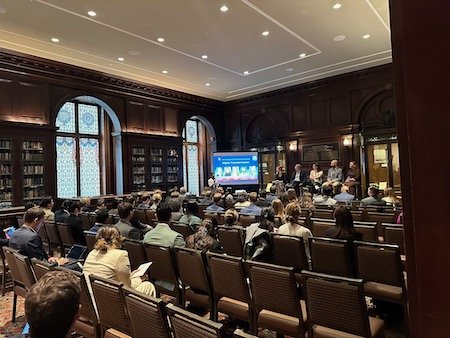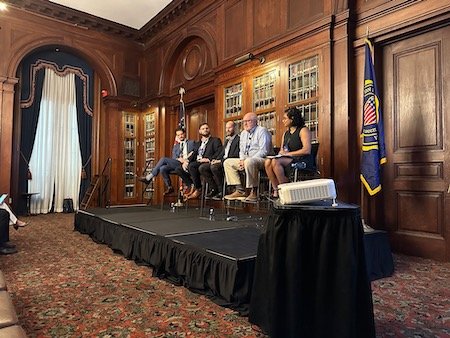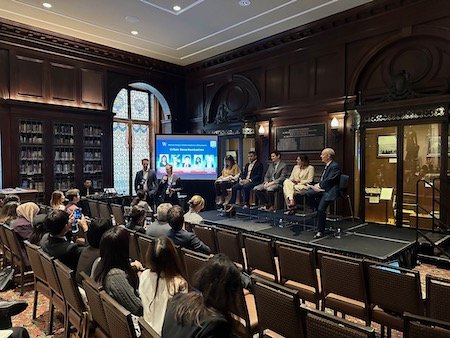Event Notes: The Wharton Energy and Climate Conference of 2023
Earlier this week I attended the Wharton Energy and Climate Conference, at the Union League of Pennsylvania in Philadelphia.
Established in 2007, this event is “now one of the largest energy conferences in the Northeast. It brings together 300+ people and builds on Wharton’s strong focus on energy and the active alumni members of the Wharton Energy Network”. According to their website, “the conference promotes dialogue and creates connections between current and future leaders across the energy and climate landscape.”
The agenda was full of interesting topics and speakers, and what attracted me to this one-day event in the first place. Given that roadmap and schedule for the day, the beautiful venue of the historic Philadelphia Union League, and this year’s theme of “Energy in 3D: Digitize, Decentralize, Decarbonize”, the event did not disappoint.
The event is organized by Wharton’s Energy and Climate Club, a social and professional organization of students and alumni. Speakers included senior energy industry professionals, venture capital companies, advisors, and US federal government representatives. Members of the University of Pennsylvania academic community often acted as panel moderators, while attendees seemed mostly graduate students (Wharton MBAs plus a few undergraduates, and alumni), folks from other organizations and otherwise relatively few outside participants.
Here are my main take-aways from the event:
The Energy Sector is Exhibiting Substantial Growth and Transformation - with More On The Way
The last 10-15 years in the energy transition space have been remarkable. For example, since the first Wharton energy conference in 2007, solar power generated in the US grew from 8 GW to 1,500 GW, global investments in clean energy grew from $150 billion to $1.4 trillion in 2022, and the number of electric vehicle charging ports in the US grew from 417 in 2007 to 137,000 in 2022.
This is staggering growth, and yet not enough to fully transition our fossil fuels-dependent economy and infrastructure to clean, renewable energy sources.
A major theme emerging throughout the event is that there is still dramatic, double-digit growth ahead, both in (A) conventional renewable energy like hydro, wind, and solar, as well as (B) what’s deemed the “new” renewable, such as hydrogen, nuclear (fusion), and carbon capture technologies. This latter category is more controversial, as it is neither fully “clean”, nor renewable, since many such technologies rely on fossil fuels as inputs, such as methane, commonly known as natural gas, or produce significant CO2 emissions (for example, blue or gray hydrogen).
Overall, the energy transition is the highest growth sector currently, as it sits at the heart of a multi-generational, revolutionary shift on all aspects of our economy. In addition, there is significant government support and funding, acting as further tail wind. For example, in the US we have the the Bipartisan Infrastructure Act of 2021 as well as the Inflation Reduction Act (IRA) of 2022 which are providing historic level incentives, subsidies, and tax credits.
Most of the Money (So Far) Is in Mitigation
Addressing the effects of humanity’s historic and current use of energy sources on climate, requires two main categories of action: mitigation and adaptation:
Mitigation refers to reducing our greenhouse gas emissions, to align to the goals of the Paris Agreement of 2015.
Adaptation means climate-proofing life on earth, as our one beautiful planet will inevitably get hotter.
Mitigation strategies involve the transition to renewable energy sources, away from fossil fuels. It is a monumental task for most industries, but in some sectors, such as shipping, we have started to see a multiple stakeholder collaboration be successful, through the creation of the Poseidon Principles: a global framework for integrating climate considerations into lending decisions to promote international shipping decarbonization.
The large majority of initiatives, investments, and economic activity (and indeed the conference panels and sessions...) relate to mitigation strategies. But we are late, and as one of the speakers said, quoting environmentalist Bill McKibben, “winning slowly is the same as losing”: it is becoming increasingly clear the world will not be able to radically cut emissions in order to slow warming.
Therefore, inevitably there will also have to be adaptation. However, so far adaptation as a strategy and sector has attracted comparatively significantly less interest from investors and the business community. Several speakers highlighted an expected rapid growth in that space, yet also mentioned it is harder to see “who’s paying”, and therefore building a resilient and compelling business case.
The Union League building on Broad Street, Philadelphia
Final Thoughts
Overall, this was an insightful event, offering a glimpse into broad energy sector trends.
Well-organized, in a beautiful venue, with high caliber speakers, it provides a great learning and networking opportunity. It was time well spent and worth the conference ticket price.
Beyond the content, the Wharton conference is an excellent demonstration of what effective collaboration looks like, among key stakeholders: the business community, government, and academic institutions. It is an example for other similar student clubs and colleges in the area, such as Drexel University’s Climate and Sustainability program and Temple University’s EcoReps program.






